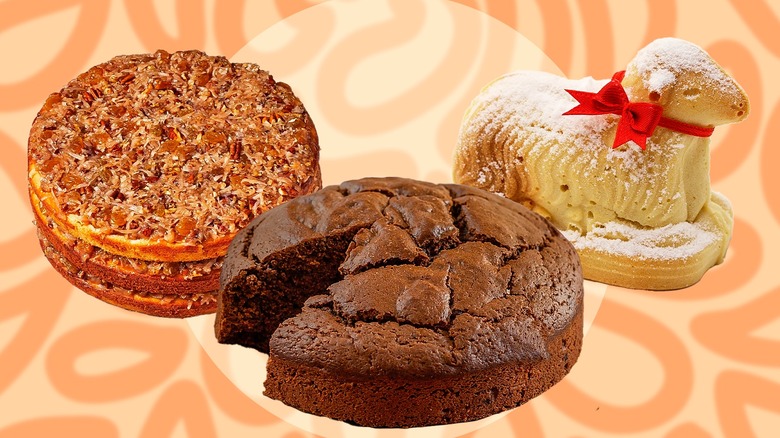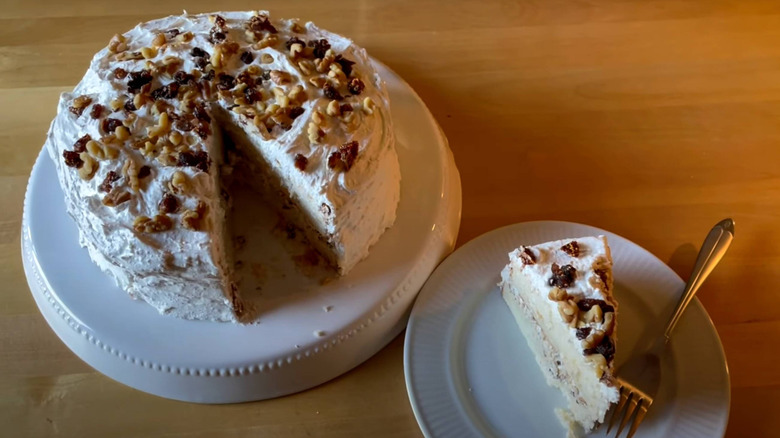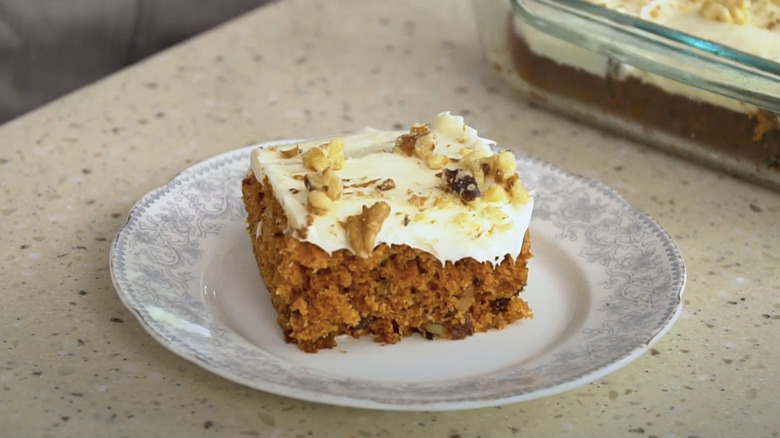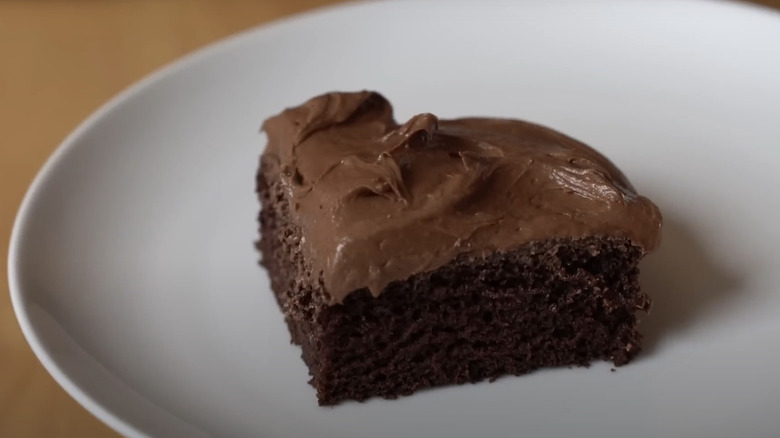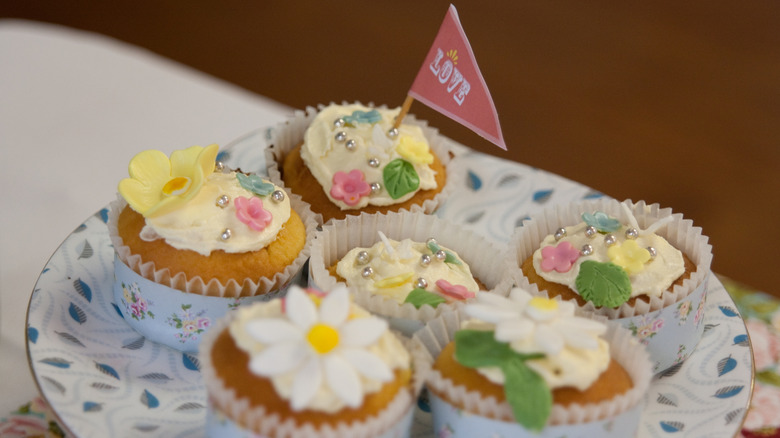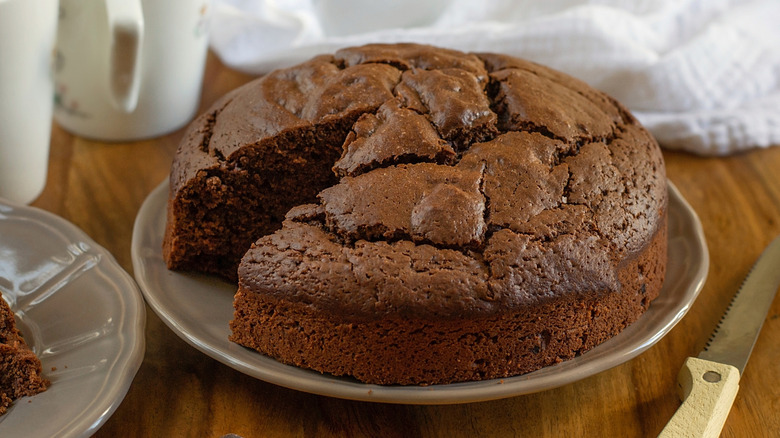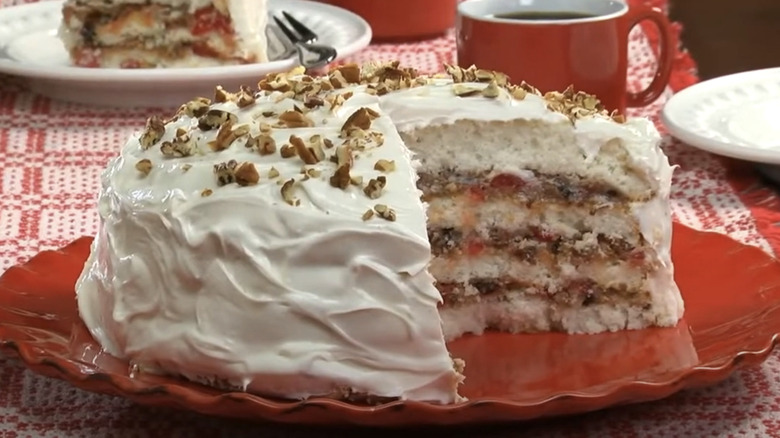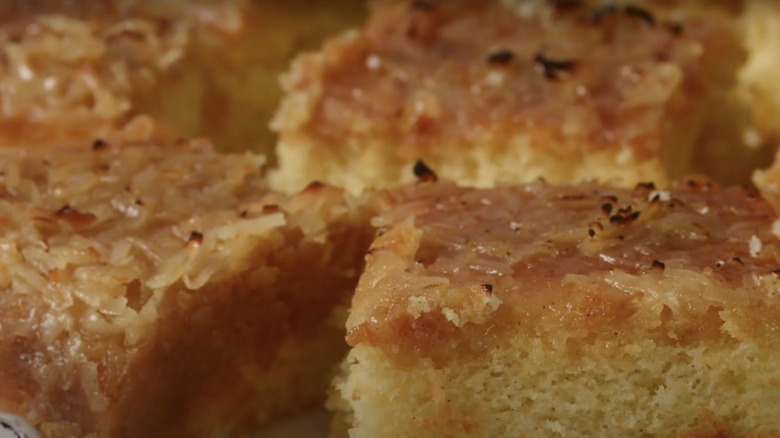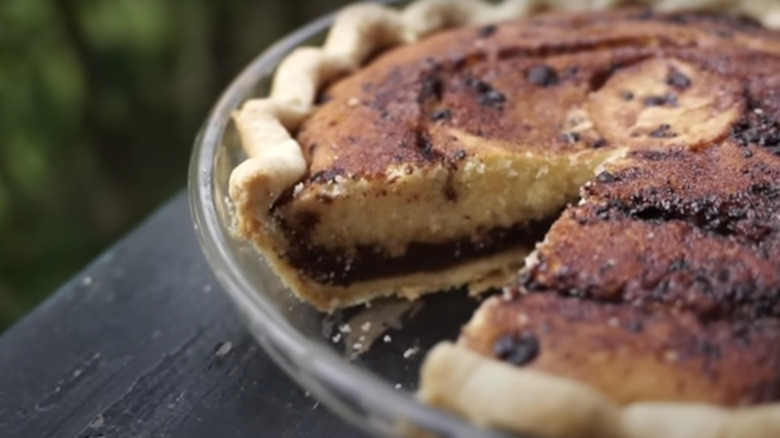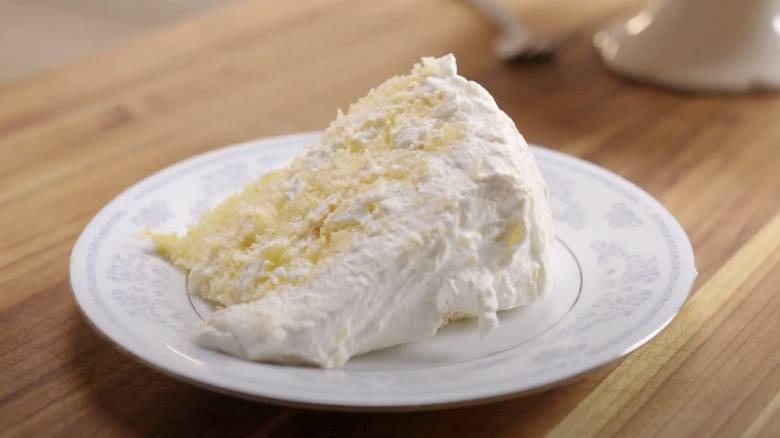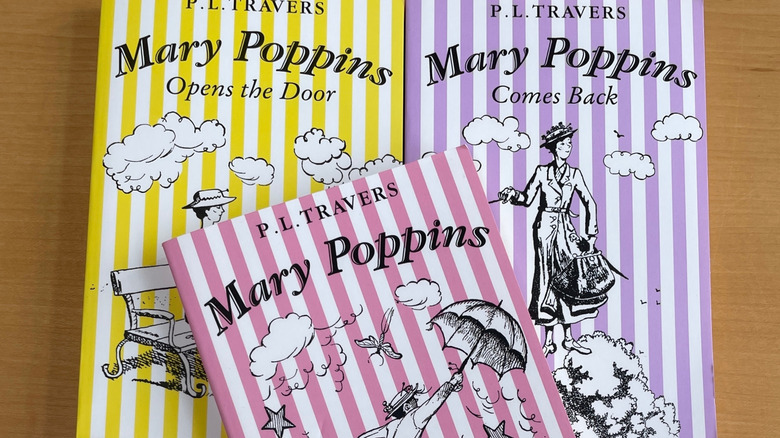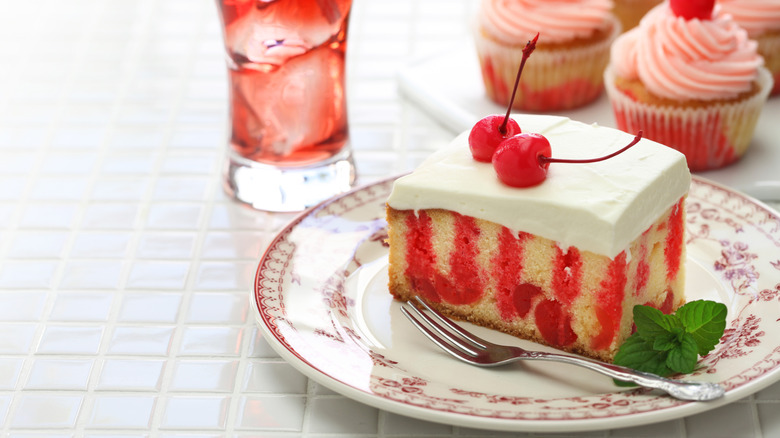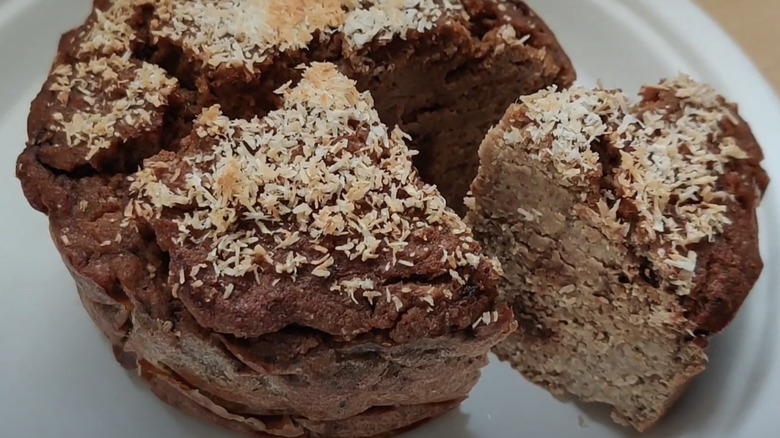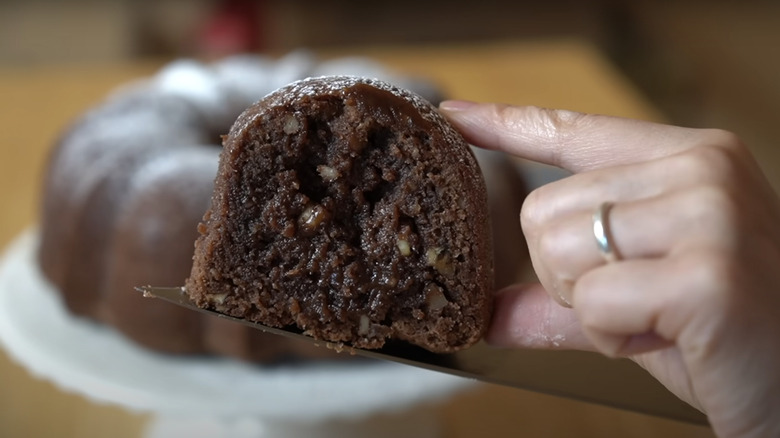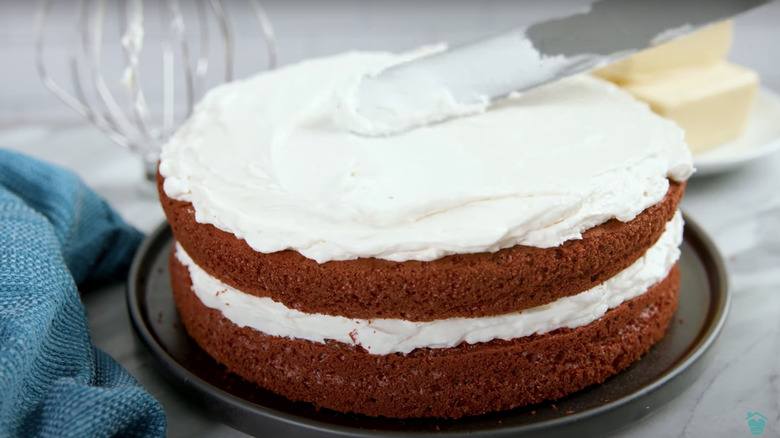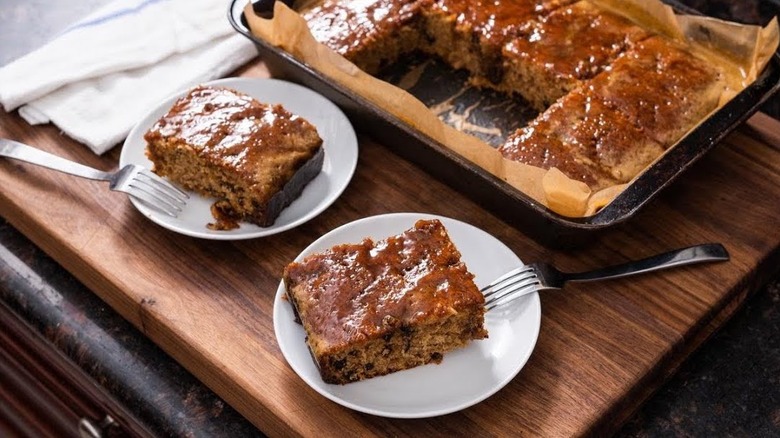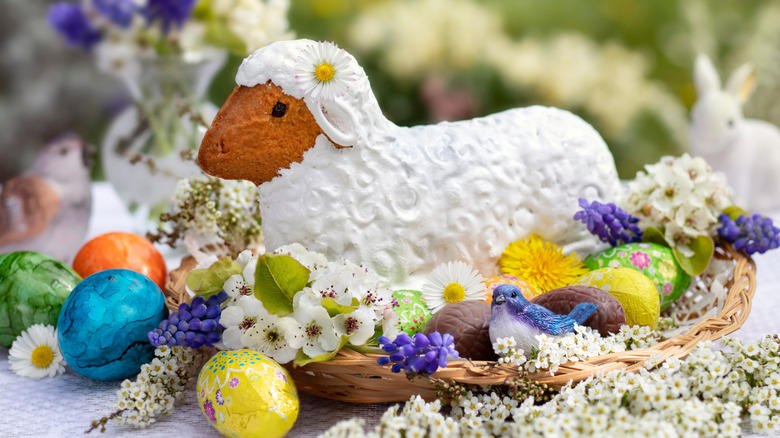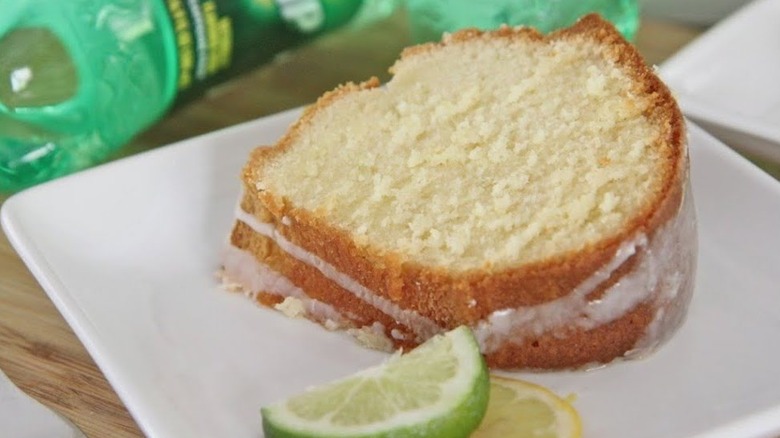17 Nostalgic Cakes You Probably Forgot Existed
Think back to your childhood and the cakes you and your friends ate then. No doubt some of them were classics like chocolate or yellow cake. However, others might have been cakes that were popular back then but aren't now. For many cakes, their time in the spotlight soon disappears. What had been a popular cake that everyone seemed to make weekly suddenly fades into obscurity, occasionally resurrected by a food blog or YouTube channel looking for interesting recipes in retro cookbooks.
Of course, some of these cakes may still be a part of your personal recipe rotation. Some are still regional favorites, and others have even made mini comebacks thanks to eager foodies. While these cakes may not have totally vanished from the culinary scene, they're just not the types of cake that most people think of anymore when deciding to bake something. It's really time to bring these cakes back, so let's give them more attention. Here are 17 nostalgic cakes you may have forgotten about, and the next time you bake a cake, perhaps give one of these a try.
1. Lady Baltimore cake
Lady Baltimore cake is a two-layer white cake topped with a light meringue or boiled frosting. The filling between the layers contains a mix of chopped nuts and dried fruit, and it's still rather popular in the southeastern United States.
This cake's origins are obscure; food historians know that the first printed version of the recipe appeared in 1906 and that the cake's name was likely based either on the Lady Baltimore Tea Room in Charleston, South Carolina, or on a fictional character named Lady Baltimore in a book set in Charleston. In that book, authored by Owen Wister, the character made a cake that set off a storm of interest because its short description made it sound so luscious and sweet. Unfortunately, there was no recipe in real life. But the proprietors of the Lady Baltimore Tea Room already had a similar cake that they'd ship to customers, and one of those customers was reportedly Wister himself.
The cake portion of a Lady Baltimore cake is a soft white cake; delicious, but standard. You can even use a boxed mix, according to some recipes. The decadent nut- and fruit-filled frosting between the layers of cake is what makes it stand out from other white cakes.
2. Tomato soup cake
Tomato soup cake is a spice cake, made with condensed tomato soup. It was created around the 1920s or 1930s by an unknown cook, and it was used as a cheap emergency cake that didn't need eggs. In the 1940s, the Campbell's Soup Company created its own version, using the same tomato soup that Andy Warhol was obsessed with, first as a steamed pudding and later as a spice cake. It really took off once boxed cake mixes became popular in the 1950s and 1960s.
As strange as it sounds to have vegetable soup in a cake, it's really not that weird. Batter with shredded or puréed vegetables is already used for baking carrot cake or pumpkin cake, so cake with tomato soup isn't that different. And, like carrot and pumpkin cakes, tomato soup cakes were often topped with cream cheese frosting starting in the 1970s. There was even a fruitcake version for the holidays. The soup adds both flavor and moisture, and some versions of the original recipe include a topping of nuts and raisins. You can still find the older egg-free recipes, but recipes including eggs are out there too.
3. Vinegar cake or wacky cake
Vinegar cake, wacky cake, Depression cake — these names all refer to the same thing, a cake made without dairy or eggs, that uses vinegar and baking soda to help the batter rise. The recipe has been around at least since World War II, when it allowed people to make cakes despite the rationing of ingredients like butter. It experienced periodic revivals as people who remembered the cake from their childhoods grew up and started baking it for their families. Wacky cakes continue to live on in food blogs, but they're not something you'll find in bakeries.
One of the characteristics of the original recipes was that you could mix the batter right in the pan — although nowadays, many people mix the batter in a separate bowl because trying to combine ingredients in a square pan can lead to uneven mixing. Chocolate is a very common flavor, but you can also make this in vanilla and other flavors. You'll also find varying amounts of vinegar in different recipes for the cakes.
4. Chintz cake
Chintz cake was created by the Presto company to showcase its cake flour; essentially, a "back of the box" recipe. The cake itself was a basic yellow cake with grated orange rind mixed in, plus an orange-flavored frosting. The "chintz" part referred to the decoration. Chintz is a type of fabric with a repeating floral pattern and a smooth sheen, and the decorations on this cake used candies and nuts to imitate flowers.
Chintz cake is a great example of the many back-of-the-box recipes that have come and gone. These were recipes created to use a specific product, and they were meant to be easy to make and delicious to eat. A number of well-known recipes were originally back-of-the-box recipes, including green bean casserole and Rice Krispies Treats. But there are many others that were tested to near-perfection but have since faded away. If your family used to make some back-of-the-box recipes but no longer makes them, go dig them up and try them again.
5. Chocolate mayonnaise cake
Mayonnaise haters may be happy to see this cake drift further into the past, but those of you willing to entertain the thought of mayo in cake will love this recipe. Chocolate mayonnaise cake is exactly that: Chocolate cake with mayo in the batter, replacing eggs and oil in the recipe. It makes the cake moist and rich, while the chocolate covers up the taste.
The cake's origins are murky. One version that was popular in the 1950s was invented in the 1930s by the wife of someone who worked with the Hellmann's mayonnaise company, but mayonnaise in chocolate cake is older than that. In fact, the first known print version of a chocolate mayonnaise cake appeared in 1927. This type of cake, just like wacky cake, was a popular dessert during World War II, when rationing reduced the amount of dairy available. You can imagine why people flocked to these recipes.
6. Lane cake
Lane cake is another treat that's popular in the South but that's not very common in other parts of the country. This is a three- to four-layer cake covered in boiled frosting. The filling between layers is a custard that originally contained just raisins, but now it can include nuts and shredded coconut. It's also mixed with plentiful bourbon or brandy; depending on the recipe, you may have to add up to 3 cups of alcohol.
The cake gained national attention after it was mentioned in Harper Lee's "To Kill a Mockingbird" and printed in cookbooks. It's since become a popular holiday cake, typically associated with Georgia, Mississippi, and Alabama. The cake's creator, Emma Rylander Lane, based the cake on two other existing cakes. One was the 1-2-3-4 cake, where 1-2-3-4 refers to the proportion of butter, sugar, flour, and eggs, with a notable difference that the Lane cake uses egg whites instead of whole eggs. The filling was inspired by one used in Minnehaha cake, a popular cake from Minnesota in the 1870s.
7. Lazy daisy cake
Lazy daisy cake shows up in a few forms, one as a basic snack cake with a sweet coconut and brown sugar frosting, another with oatmeal mixed into the batter, and yet others made with fruit. "Lazy daisy" refers to the simplicity of the frosting recipe, which is mixed, spread on the cake, and then briefly broiled (yes, broiled, not boiled) to make the frosting look toasted. The oat versions often include a lot of brown sugar in the cake batter.
The recipe first appeared around the 1930s in a version that called for old-fashioned rolled oats in the batter, and the recipe had a bit of a renaissance in the 1960s when quick oats were invented. Meant as a cake for everyday eating, the recipe is generally simple, but the use of the broiler does require some care — the topping can go from caramelized to crispy very quickly, so you need to keep an eye on your cake.
8. Funny cake
Funny cake sure is funny, because it's really a pie made with cake batter. What's more, it's an early version of those desserts where you pour a couple of layers of ingredients into a pan, and the two end up reversed when the cake is fully baked. What's even funnier is that people don't always agree on which layer goes first, although many home cooks seem to pour the cake batter first.
In funny cake, which is a Pennsylvania Dutch recipe, you pour a layer of either chocolate or cake batter into a pie shell. Then you top that with whichever layer you hadn't poured in yet. The cake is supposed to end up looking like a thick layer of cake over a thin layer of chocolate, so in recipes where you pour in the batter first, the batter and chocolate layers actually reverse, with the batter rising and the chocolate sinking.
9. Pig pickin' cake
Pig pickin' cake is another Southern cake that is still regionally popular but not that common elsewhere. This is a yellow layer cake with a frosting made of whipped topping, pudding, pecans, and pineapple. The cake batter is sometimes mixed with mandarin segments. As you can guess from the very light frosting, this is traditionally a summertime cake.
The name also gives you a clue as to the cake's origins. It was a very common dessert at barbecues featuring a whole pig, and it likely got its start in North Carolina. The idea was that you'd eat the cake after picking meat off the pig. However, it's unknown in which year it first appeared because the cake may have evolved from home recipes mixed up to use canned ingredients. You can find recipes for several versions, for cakes with nuts of coconut, or the classic cake addition of vanilla.
10. Mary Poppins zodiac cake
Some cakes have been forgotten, but if you weren't a Mary Poppins fan, you might not have known this cake ever existed in the first place. P. L. Travers, the author of the original Mary Poppins books, actually created a cookbook of recipes based on the character in 1975 called "Mary Poppins in the Kitchen." The book is divided into two sections, and one is a story about Poppins being called upon to cook for the children when both the parents and cook are away for a weekend. The other section is the actual cookbook, including this "zodiac cake" and several other recipes.
Zodiac cake is just a single-layer snack cake with nuts in the batter. In the book, the cake has silver stars as a decoration that give the cake its name. Versions posted online usually use stencils and silver-colored decorating sprinkles to achieve that effect.
11. Jell-O poke cake
This nostalgic cake first appeared in the 1970s as a one-layer white cake where you poked holes in the top of the baked cake with a wooden spoon handle or chopstick, and then you poured liquid Jell-O over the top of the cake before frosting it with whipped cream. The result was a flavored white cake with colorful streaks. You could use any color and flavor of Jell-O too, like using red and green Jell-O for Christmas.
The cake never fully went away, but it didn't get much notice for years until recently. One vlogger's enthusiastic video saw him go from eyeing the recipe suspiciously to fully enjoying the finished cake. It's really one of the easiest cakes you can make because the only requirements are to use a white cake (boxed, homemade, doesn't matter) and to be careful the holes don't go all the way through the baked cake.
12. Pinto bean cake
This recipe is an exercise in trust. Cooked pinto beans plus, depending on the recipe, cloves, raisins, apples, nuts, and other spices are mixed into a batter with the usual cake ingredient suspects. It doesn't sound like it should work. It doesn't even look like it should work, with the batter sometimes turning into a thick, stretchy-looking mess. But work it does, and the result reportedly ends up tasting remarkably good, so if you're trying to get more fiber into your diet, this could be an avenue.
It shouldn't be so surprising that this works. After all, recipes for chocolate black bean cakes have been popular for a while. This is just a non-chocolate version with a lighter bean. The origin of pinto bean cake is unknown, but printed versions appeared at least as early as the 1970s. It wouldn't be much of a stretch to speculate that the cake originated even earlier as a way to use up ingredients or provide nutrition in tough times.
13. Tunnel of fudge cake
Tunnel of fudge cake is baked in a Bundt pan gets its name from a "tunnel" of fudgy icing that appears through the center of the cake while baking. The cake was the second-place winner of the 1966 Pillsbury Bake-Off and was the creation of Mrs. Ella Rita Helfrich of Houston, Texas. Despite the second-place ranking, the cake quickly became a favorite of Pillsbury customers and may be a big reason why Bundt cakes are so common in baking now.
Bundt cakes had been around for years, but people just didn't really pay attention to them the way they might a round layer cake. But after the tunnel of fudge cake arrived on the scene, sales of Bundt pans went bonkers. Pillsbury ended up creating boxed cake mixes meant for Bundt pans and even licensed the name of the pan from the Nordic Ware company. You can still make the cake now, obviously, but some of the mixes used in the original recipe are no longer in production. Thankfully, it's not difficult to substitute these when baking at home.
14. Mahogany cake
Mahogany cake has an interesting place in baking. It was technically the first version of chocolate cake in the U.S., dating from the late 1800s, and may have been the first version of a red velvet cake. Mahogany cake was actually part of a group of cake recipes known as velvet cakes; they got that name from the combination of baking soda plus vinegar or buttermilk that made the texture of the cake soft and velvety. The combination also changed the color of the cocoa from brown to reddish-brown. The cake was originally topped with ermine frosting, a very light type of boiled-milk buttercream.
Eventually, bakers started adding food coloring to make the cake look even redder inside, which gave way to the modern red velvet cake. Other bakers started making a version that used unsweetened baking chocolate instead of cocoa powder, leading to devil's food cake.
15. Prune cake
Prune cake is another cake that got its start during lean times. The Great Depression saw plenty of innovative foods, and recipes for this cake began appearing in print in the 1930s. The cakes remained popular into at least the 1950s and 1960s. It uses prunes and prune purée to create a spice cake that's topped with a boiled buttermilk glaze, and is one of those recipes that's surprisingly good despite its odd name. It's also a testament to how creative people can get when faced with ingredient shortages and economic obstacles.
You'll find plenty of variations online, some of which are family recipes and some of which were promoted by prune companies. Most family recipes produce a simpler cake, while one recipe from a prune company is meant to be a layer cake. The prunes and purée make the cake batter moist and rich.
16. Lamb cake
Lamb cake contains no lamb. Instead, it's shaped and decorated like one. This is an Easter cake that was very popular in the early and mid-20th century, although now it's more of a novelty in terms of mainstream baking. The cake itself originated in different parts of Europe, and when it came to the U.S., companies made lamb-shaped molds specifically for this once-a-year cake. The real fun of lamb cakes is in the decorating. Marshmallows, candies, swirls of frosting imitating a lamb's woolly coat — you name it, and there was probably a cake somewhere with it.
One critical safety issue to be aware of is that, even if you use a mold, you have to support the head and neck of the lamb. This often calls for skewers and other supports to be baked into the cake. This is not a cake that you want to use in a food fight, ever.
17. 7-Up cake
7-Up's version of a Coca-Cola or Dr. Pepper cake, this recipe uses the carbonation in the soda to help the batter rise. Making your batter with soda can give you extra fluffy cakes, and this is an old trick. For example, adding seltzer to potato pancake batter makes the final product have a lighter texture. The same concept works in Coca-Cola cakes. The only difference is the flavor. A 7-Up cake is a light pound cake with the lemon-lime flavor of the soda.
The 7-Up company actually created the recipe in the 1950s, and it's meant to be a Bundt cake, unlike Coca-Cola and Dr. Pepper cakes, which are sheet cakes. It can take a while to bake (up to one hour and 20 minutes, according to the 7-Up company itself), but the results are so delicious that the cake has quickly become a favorite of those who've made it for blogs and food websites.
